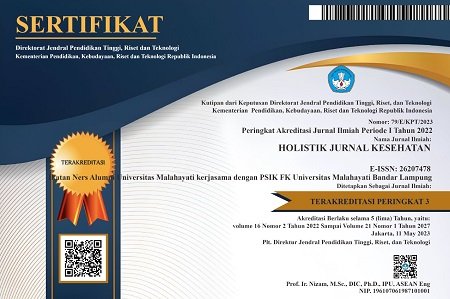Perbandingan latihan pursed lip breathing dan meniup balon terhadap peningkatan saturasi oksigen pada pasien PPOK
Abstract
Background: Several disorders in Chronic Obstructive Pulmonary Disease (COPD) affect the movement of air in and out of the lungs and result in hypoxemia and hypercapnia because of changes in oxygen saturation in the patient.
Purpose: Knowing the comparison of pursed-lip breathing and balloon blowing exercises to increase oxygen saturation in patients with COPD
Method: A Quasi-Experimental study, with pre-posttest design in two different comparison groups.
Results:There was an increase in oxygen saturation clinically because the median value before the intervention = 94, but there was no statistical difference in the increase in these two interventions, on the third and seventh day there was no statistically and clinically significant difference after the balloon blowing intervention (median = 96) and PLB (median=96), for the seventh day blowing balloons and PLB (median=99), so that p>0.181 was obtained.
Conclusion: There is no difference between pursed lip breathing and balloon blowing exercises on oxygen saturation in patients with COPD
Keywords: Pursed lip breathing; balloon blowing; oxygen saturation; COPD
Pendahuluan: Sejumlah gangguan pada Penyakit Paru Obstruksi Kronik (PPOK) berpengaruh pada pergerakan udara dari dan keluar paru, dan berakibat hipoksemia dan hiperkapnia karena terjadinya perubahan saturasi oksigen pada pasien
Tujuan: Mengetahui perbandingan latihan pused lip breathing dan meniup balon terhadap peningkatan saturasi oksigen pada pasien PPOK
Metode : Penelitian kuantitatif dengan desain Quasi-Eksperimen, dengan pre post test design pada dua kelompok perbandingan yang berbeda.
Hasil : Terdapat peningkatan saturasi oksigen secara klinis karena nilai median sebelum intervensi=94, tetapi tidak terdapat perbedaan peningkatan secara statistic dari kedua intervensi ini, hari ketiga dan hari ketujuh tidak terdapat perbedaan signifikan secara statitik dan klinik setelah intervensi meniup balon (median=96) dan PLB (median=96), untuk hari ketujuh meniup balon dan PLB (median=99), sehingga diperoleh nilai p>0,181.
Simpulan : Tidak terdapat perbedaan antara latihan pursed lip breathing dan meniup balon terhadap saturasi oksigen pada pasien PPOK.
Keywords
References
Almagro, P., & Castro, A. (2013). Helping COPD patients change health behavior in order to improve their quality of life. International journal of chronic obstructive pulmonary disease, 8, 335.
American Lung Association (2015).Lung Disease. Tersedia: http://www.lung.org/lung-disease/influenza/in-depthresources/ pneumonia-fact-sheet.html. Diakses pada 1 Januari 2018 pukul 14.00 WIB.
Balai Besar Kesehatan Paru Masyarakat Makassar.(2017). Data Sepuluh Besar Penyakit Tahun 2017. Makassar: BBKPM.
Bauldoff, G., Burke, K. M., & LeMone, P. (2019). Buku Ajar Keperawatan Medikal Bedah: Gangguan Respirasi. EGC.
Black, J. M., & Hawk, J. H. (2014).Medical surgical nursing: Clinical management forposi tive outcomes. (7th Ed.). St. Louis: Elsevier. Inc
Brunner, S., & Suddarth, D. (2002). Buku ajar keperawatan medikal bedah. Jakarta: EGC.
Dinas Kesehatan Provinsi Sulawei Selatan. (2017). Profil Kesehatan Sulawesi Selatan. Laporan Dinas Kesehatan Provinsi Sulawei Selatan 2018
Global Initiative for Chronic Obstructive Lung Disease (GOLD). (2015).Global Strategy for the Diagnosis Management and Prevention for Chronic Obstructive Pulmonary Disease
Global Initiative for Chronic Obstructive Lung Disease (GOLD).(2017).Global strategy for the diagnosis, management, and Prevention of chronic obstructive pulmonary disease (updated 2013). January 20, 2018. Global Initiative for Chronic Obstructive Lung Disease, Inc. www.goldcopd.org.
Hall, J. E. (2019). Guyton dan Hall buku ajar fisiologi kedokteran. Elsevier (Singapore) Pte Limited.
Harsismanto, J., Padila, P., Andri, J., Andrianto, M. B., & Yanti, L. (2020). Frekuensi Pernafasan Anak Penderita Asma Menggunakan Intervensi Tiup Super Bubbles dan Meniup Baling Baling Bambu. Journal of Telenursing (JOTING), 2(2), 119-126.
Kementerian Kesehatan Republik Indonesia. (2008). Pedoman Pengendalian Penyakit Paru Obstruktif Kronik, Menteri Kesehatan Republik Indonesia.
Kementerian Kesehatan Republik Indonesia. (2018). Riskesdas: angka kejadian 10 penyakit di indonesia. Retrieved from https://www.litbang.kemkes.go.id/laporan-riset-kesehatan-dasar-riskesdas
Paramitha, P. (2020). Respon pasien penyakit paru obstruktif kronis (PPOK) dengan gangguan pemenuhan kebutuhan oksigenasi terhadap penerapan fisioterapi dada di rumah sakit khusus paru “respira” (Doctoral dissertation, Poltekkes Kemenkes Yogyakarta).
Perhimpunan Dokter Paru Indonesia.(2010). Penyakit Paru Obstruktif Kronik Pedoman Diagnosis dan Penatalaksanaan di Indonesia. Jakarta: Depkes RI
Smeltzer, S. C., & Bare, B. G. (2013). Keperawatan Medikal-Bedah Brunner & Suddarth Edisi 12. Alih Bahasa Indonesia Yulianti, D & Kimin, A. Jakarta: EGC.
Windrasmara, O. J. (2012). Hubungan Antara Derajat Merokok Dengan Prevalensi PPOK dan Bronkitis Kronik di BBKPM Surakarta Tahun 2012 (Doctoral dissertation, Universitas Muhammadiyah Surakarta).
World Health Organization, (2015). Penyakit Paru Obstruktif Kronis (PPOK).
DOI: https://doi.org/10.33024/hjk.v16i1.5274
Refbacks
- There are currently no refbacks.
Copyright (c) 2022 Holistik Jurnal Kesehatan

This work is licensed under a Creative Commons Attribution-NonCommercial 4.0 International License.














